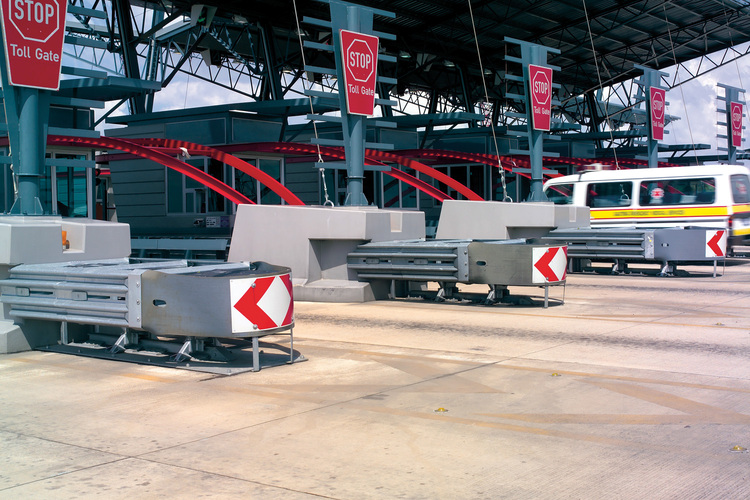The crash cushion, also referred to as an impact attenuator or an impact absorber, is a device designed specifically to reduce impact damage to vehicles and structures and injury to vehicle occupants.
The design ensures that the crash cushion absorbs the kinetic energy from the vehicle that collides with it. Such an impact attenuator can also be designed for redirecting the impacting vehicle to protect equipment, people, or structures at roadwork sites. The placement of the crash cushion is determined by what needs to be protected. In the instance of a tollbooth, the crash cushion is placed in front of the booth to protect it and the tollbooth operator from direct impacts as the result of a speeding or out-of-control vehicle. A truck-mounted crash cushion is placed at the rear of a truck. The truck is placed between the equipment or workers and traffic to protect them against direct an impact from a straying vehicle. The truck is in a high-risk position, even when it is moving slowly. The crash cushion mounted on its rear protects against high-speed rear impacts.
Impact attenuators or crash cushions are categorised according to the method used for distributing the impact’s kinetic energy. There are three categories. The first is where the attenuator consists of crushable materials to absorb the impact energy. The second type is a friction-based attenuator where a strap is forced through an angled tube to convert the impact energy into heat. The third type has several rows of sand- or water-filled modules where the kinetic energy is transferred to the water or sand to reduce the impacting vehicle’s speed. A water- or sand-filled crash-cushion system is normally placed on the ground without anchors. This type of cushion does not redirect the impacting vehicle but can deflect it if the impact is at an angle.
Gating and Non-Gating
There is also a distinction between a gating and a non-gating crash cushion. The gating type allows a vehicle to pass through if it is hit from the side. The gating type requires sufficient clear space around the cushion to minimise the risk of the errant vehicle hitting another object once it has passed through. The non-gating crash cushion is an attenuator that stops vehicle movement upon a head-on impact. If hit at an angle, it deflects the errant vehicle. The non-gating type is anchored to the ground and requires less clearance around it than the gating type. What makes the crash cushion different to a water-filled barrier is that it can consist of several segments that crumple upon impact from a speeding vehicle.
A System Suited for Placement at Tollgates
We offer the QuadGuard® System as a non-gating crash cushion that is suited for use at tollgates. In fact, it sets the benchmark for crash cushions. The system consists of crushable segments that absorb impact energy. These segments are placed in a frame consisting of steel panels. The system has a modular design for anything from one to 12 tollbooths. Each unit can accommodate speeds ranging up to 120 km/h, making it possible and effective to use the crash-cushion system at tollgates on highways. The system features quad-beam panels, ensuring 30% higher beam strength than with the thrie-beam system. The staged design of the cartridges enables a safe reduction of the speed of both light and heavy vehicles. Other features that add to the strength, efficiency, and reusability of the QuadGuard® System include:
- A self-supporting end, called the nose. The nose does not require legs and as such, no installation or maintenance is required for anchors at the nose.
- Monorail base. No tension or anchor chains are needed and the installation time is thus reduced.
- Backups, such as a concrete or tension strut, can be used according to your requirements.
The system has a high level of reusability. In fact, 80% of the system can be used again, which allows for faster repairs and lower cost in terms of maintenance. Normally, after a head-on collision from an erring vehicle, only the plastic nose and the cartridges require replacement. The debris from the impact is contained within the cartridges. This further helps to reduce repair time.
View more information about Armco Superlite’s QuadGuard® System and get in touch for a quote or assistance in selecting the most suitable crash cushion for your particular application.

